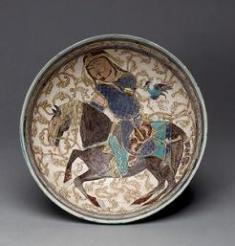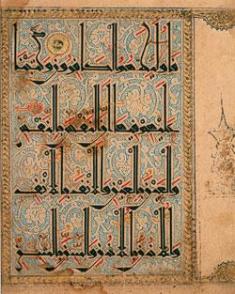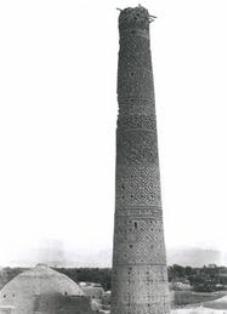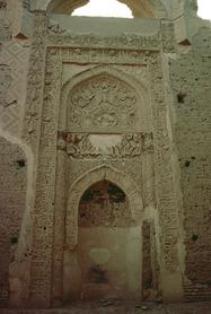The Great Seljuks (r. 429 - 590 AH / 1038 - 1194 CE) were a division of the Kiniq clan of Oghuz Turks, from the steppes north of the Aral Sea (lake in Central Asia). Initially, in the service of Qarakhanids of Transoxiana, they belonged to the leading tribe of the Oghuz Turks, and adopted Islam around 348 AH / 960 CE under their tribal leader named Seljuk.
The Seljuks came to reign over Afghanistan, Persia, Eastern Anatolia, Iraq, Syria, and on the Arabian Peninsula from 429-590 AH / 1038-1194 CE. Seljuk’s grandsons, Tughril (r. 429-455 AH / 1038-1063 CE) and Chaghri (r. 429-542 AH / 1038-1060 CE), divided the territory into Eastern-half centered around Marw and the Western-half with Isfahan being the focal point. Subsequently, these became the main centres of their political power in Persia.
Tughril, following his victory over the Ghaznavids in 431 AH / 1040 CE at Dandanqan, extended the empire to the west; he conquered Iraq and parts of Anatolia (Asian Turkey) after 433 AH / 1042 CE. As the protector of the Abbasid caliph in Baghdad and as a military commander and sultan, Tughril replaced the Buyids in 447 AH / 1055 CE in the region of Daylaman.
Within fifty years, the Seljuks came to amass vast territories under their rule which included the whole of Iran and Iraq, and much of Anatolia (Asian Turkey). The Seljuks consolidated their political power during the reigns of Alp Arsalan (r. 455/58-464 AH / 1060/63-1072 CE) and Malik Shah I (r. 464-485 AH /1072-1092 CE). With the support of their prominent vizier, Nizam al-Mulk (ca. 452/57-485 AH / 1060/65-1092 CE), they established Sunni Islam as the state religion and built madrasas across their territories to support the Shafi' Sunni outlook of the state. Among the most prominent was the Nizamiya Madrasa in Baghdad, founded by the Seljuk vizier Nizam al-Mulk (d. 457 AH / 1092 CE) where the famous Muslim scholar of theology and philosophy, al-Ghazali (d. 505 AH / 1111 CE) taught. The great Persian poet Sa‘di Shirazi (d. 690 AH / 1291 CE) also studied at the Nizamiya in Baghdad, where he excelled in theology, history and Arabic literature. Other prominent Nizamiyyas were built in Balkh, Herat, Isfahan and Nishapur.
Upon the death of Sultan Malikshah I (d. 484 AH / 1092 CE), his brother and sons fought over the succession. As a result, the Seljuk Empire came to have three divisions: Persian, Syrian and Anatolian. In the Persian division (Iran/Iraq), Malikshah’s son Mahmud I ascended to power, however, his reign continued to be threatened by his brothers Barkiyaruk and Muhammad I (in Iraq) and Ahmad Sanjar (in Khurasan). In the Syrian territories, Malikshah’s was succeded by his brother Tutush I who established Damascus and Aleppo as political centres. In Anatolia power was held by Qilij Arsalan ( r. 469-478 AH / 1077-1086 CE), son of Suleyman b. Qutalmish who had founded an Independent Seljuk Turkish state in Anatolia.
Citation
Hattstein, Markus and Peter Delius, Islam: Art and Architecture, (Cologne: Könemann, 2000).
Peacock, A. C. S, Early Seljuq History: A New Interpretation, (Routledge: New York, NY, 2010).
‘Akbar al-Dawlat Al Saljuqiya: An Arabic chronicle on the history of the Great Saljuq dynasty in Iran and Iraq.’ Encyclopedia Iranica. 2011.
http://www.iranicaonline.org/articles/akbar-al-dawlat-al-saljuqiya [accessed July 2013]
Previte-Orton, C. W. The Shorter Cambridge Medieval History, (Cambridge: Cambridge University Press: 1971).
Seljuks of Iran (aka Great Seljuk)
http://www.archnet.org/timelines/48/period/Seljuk%20of%20Iran%20(aka%20Great%20Seljuk)/year/1040 [accessed February 2014]
The Art of the Seljuks of Iran
http://www.metmuseum.org/toah/hd/iselj/hd_iselj.htm [accessed August 2013]
Seljuks and their Successors
http://www.davidmus.dk/en/collections/islamic/dynasties/seljuks [accessed August 2013]



